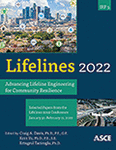Evaluating Cyclic Loading Response of a Low Plasticity Silt with Laboratory and Field Cyclic Loading Tests
Publication: Lifelines 2022
ABSTRACT
The cyclic behavior of a fine-grained low plasticity silty soil (plasticity index of approximately 15) at a site in Portland, Oregon, is characterized using a field and laboratory cyclic shear test program. The field cyclic tests were performed using the NHERI@UTexas large mobile shakers T-Rex and Rattler. The laboratory tests were performed using resonant column torsional shear and cyclic direct simple shear devices. The results of this testing program are used to evaluate the soil’s potential to develop excess pore water pressure with cyclic shear strains ranging from 0.00001% to 0.5%. The results of laboratory cyclic tests are compared against the results of field cyclic tests to predict the soil’s cyclic behavior during earthquakes. The field shaking and resonant column torsional shear tests showed significantly lower pore pressure ratios at shear strains up to 0.5% when compared to cyclic direct simple shear tests. These data will contribute to the larger body of knowledge of the cyclic behavior of low plasticity silts.
Get full access to this article
View all available purchase options and get full access to this chapter.
REFERENCES
Bauer, J. M., Burns, W. J., and Madin, I. P. (2012). “, Earthquake regional impact analysis for Clackamas, Multnomah, and Washington counties, Oregon.”
Boulanger, R. W., and Idriss, I. M. (2006). “Liquefaction susceptibility criteria for silts and clays.” Journal of Geotechnical and Geoenvironmental Engineering, ASCE, 132(11), 1413–1426.
Bray, J. D., and Sancio, R. B. (2006). “Assessment of the liquefaction susceptibility of fine-grained soils.” Journal of geotechnical and geoenvironmental engineering, ASCE, 132(9), 1165–1177.
CH2M Hill. (2008). “I-5 Tacoma/Pierce County HOV Program Portland Avenue to Port of Tacoma Project Puyallup River Bridge (BR 5/456) Site-Specific Seismic Ground Response Analysis,” CH2M Hill, Bellevue, Washington.
CH2M Hill. (2009). “WSDOT General Mark W. Clark Memorial Bridge (532/2) – Seismic Response Studies XL-2770,” CH2M Hill, Bellevue, Washington.
Cox, B. R., Stolte, A. C., Stokoe, K. H., and Wotherspoon, L. M. (2018). “A Direct-Push Crosshole (DPCH) Test Method for the In Situ Evaluation of High-Resolution P- and S-Wave Velocities.” Geotechnical Testing Journal, 42(5).
Cox, B. R., Stokoe, K. H., and Rathje, E. M. (2009). “An In Situ Test Method for Evaluating the Coupled Pore Pressure Generation and Nonlinear Shear Modulus Behavior of Liquefiable Soils.” Geotechnical Testing Journal. 32(1).
DeGroot, D. J., and Ladd, C. C. (2012). “Site characterization for cohesive soil deposits using combined in situ and laboratory testing.” Geotechnical Engineering State of the Art and Practice: Keynote Lectures from GeoCongress 2012, Geotechnical Special Publication, 2012, No. 226. ASCE Geo‐Institute, pp 565–608.
Dobry, R., Pierce, W. G., Dyvik, R., Thomas, G. E., and Ladd, R. S. (1985). Pore pressure model for cyclic straining of sand. Rensselaer Polytechnic Institute, Troy, New York.
Dyvik, R., Berre, T., Lacasse, S., and Raadim, B. (1987). “Comparison of truly undrained and constant volume direct simple shear tests.” Géotechnique, 37(1), 3–10.
GRI. (1989). “Geotechnical Investigation for Proposed Sunderland Restitution Center; Northeast Portland, Oregon,”, GRI, Beaverton, Oregon.
GRI. (1995). “Geotechnical Investigation, United Van Lines/Schwartz Moving and Storage, West of NE 33rd St On Sunderland Road Portland, Oregon,”, GRI, Beaverton, Oregon.
Hazirbaba, K., and Rathje, E. M. (2009). “Pore pressure generation of silty sands due to induced cyclic shear strains.” Journal of geotechnical and geoenvironmental engineering, ASCE, 135(12), 1892–1905.
Hull, D. A. (1991). “Geologic Map of the Portland Quadrangle, Multnomah and Washington Counties, Oregon, and Clark County, Washington.”, Department of Geology and Mineral Industries.
Hyde, A., Higuchi, T., and Yasuhara, K. (2006). “Liquefaction, cyclic mobility, and failure of silt.” Journal of geotechnical and geoenvironmental engineering, ASCE, 132(6), 716–735.
Kulhawy, F. H., and Mayne, P. W. (1990). Manual on estimating soil properties for foundation design, tech., EPRI, Palo Alto, California.
Moug, D., Khosravifar, A., Preciado, M., Sorenson, K., Stokoe, K., Menq, F., Zhang, B., van Paassen, L., Kavazanjian, E., Jr., Stalling Young, E., and Wang, Y. (2020). “Field Evaluation of Microbially Induced Desaturation for Liquefaction Mitigation of Silty Soils.” 17th World Conference on Earthquake Engineering (17WCEE), Sendai, Japan.
Price, A. B., DeJong, J. T., and Boulanger, R. W. (2017). “Cyclic loading response of silt with multiple loading events.” Journal of geotechnical and geoenvironmental engineering, ASCE,143.10.
Shannon and Wilson. (2004). “SR 99 Alaskan Way Viaduct and Seawall Replacement Project, Seismic Ground Motion Study Report,” Shannon and Wilson Inc., Seattle, Washington.
Sorenson, K., Preciado, A. M., Moug, D., Khosravifar, A., van Paassen, L., Kavazanjian, E., Jr., Stokoe, K., and Menq, F. “Field Monitoring of the Persistence of Microbially Induced Desaturation for Mitigation of Earthquake Induced Soil Liquefaction in Silty Soil”. Submitted to ASCE Lifelines Conference 2021 (under review).
Towhata, I., Gunji, K., Hernandez, Y. A., and Yamada, S. (2013). “Laboratory tests on cyclic undrained behavior of loose sand with cohesionless silt and its application to assessment of seismic performance of subsoil.” NZ – Japan Workshop, Dec 2-3, U. of Auckland, NZ.
Valle-Molina, C., and Stokoe, K. H. (2012). “Valle.” Canadian Geotechnical Journal, 49(6), 671–685.
Wang, Y., Bartlett, S. F., and Miles, S. B. (2012). Earthquake Risk Study for Oregon’s Critical Energy Infrastructure Hub, State of Oregon, Salem, OR.
Wang, Y. (2018). Development of constitutive models for linear and nonlinear shear modulus and material damping relationships of uncemented soils. The University of Texas at Austin, Dissertation, 467 pp.
Wijewickreme, D., Achala, S., and Priyesh, V. (2019). “Response of natural fine-grained soils for seismic design practice: A collection of research findings from British Columbia, Canada.” Soil Dynamics and Earthquake Engineering 124, 280–296.
Information & Authors
Information
Published In
History
Published online: Nov 16, 2022
Authors
Metrics & Citations
Metrics
Citations
Download citation
If you have the appropriate software installed, you can download article citation data to the citation manager of your choice. Simply select your manager software from the list below and click Download.
